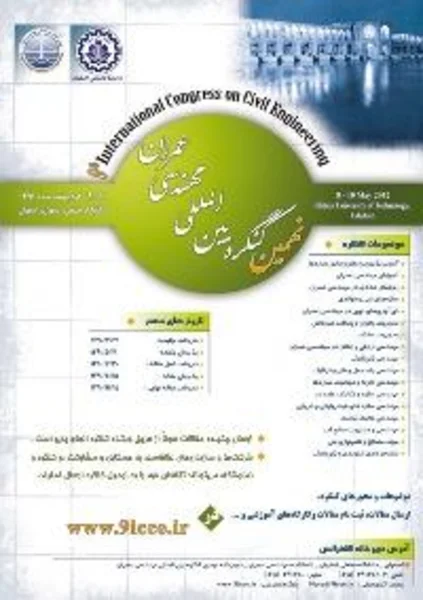-
new generation of tsunami hazard assessment for southern iran
جزئیات بیشتر مقاله- تاریخ ارائه: 1390/11/15
- تاریخ انتشار در تی پی بین: 1390/11/15
- تعداد بازدید: 790
- تعداد پرسش و پاسخ ها: 0
- شماره تماس دبیرخانه رویداد: -
we reassess the tsunami hazards associated with the makran subduction zone (msz) offshore southern coasts of iran and pakistan based on the lessons learned from the large japan earthquake and tsunami on march 11, 2011. the large m9+ earthquake offshore northwestern japan surprised many seismologists and caused extreme destruction and death toll because no one was prepared for such an extreme earthquake and tsunami. this event showed that earthquakes larger than what we expected normally from subduction zones can occur in world’s subduction zones, and hence we may take into account worst-case scenarios for tsunami hazard assessment. in this study, based on historical earthquakes in the msz, we defined a worst-case scenario earthquake for the region and then calculated the distribution of tsunami heights along the southern coast of iran bordering the indian ocean. our scenario earthquake is an mw 9 earthquake which is capable of rupturing the full length of the plate boundary along the msz. the resulting tsunami can produce wave heights up to 15 m along the coastlines of the region which is more than twice larger than the values calculated in the framework on the first generation of tsunami hazard assessment for the region. the results may help to understand the effects of an extreme tsunami and earthquake in the region. the 2011 japan tsunami taught us that we have to be prepared for worst-case scenarios.
مقالات جدیدترین رویدادها
-
استفاده از تحلیل اهمیت-عملکرد در ارائه الگوی مدیریت خلاقیت سازمانی و ارائه راهکار جهت بهبود
-
بررسی تاثیر ارزش وجوه نقد مازاد بر ساختار سرمایه شرکت های پذیرفته شده در بورس اوراق بهادار تهران
-
بررسی تأثیر سطح افشای ریسک بر قرارداد بدهی شرکت های پذیرفته شده در بورس اوراق بهادار تهران
-
بررسی تأثیر رتبه بندی اعتباری مبتنی بر مدل امتیاز بازار نوظهور بر نقد شوندگی سهام با تأکید بر خصوصی سازی شرکت ها
-
تأثیر آمیخته بازاریابی پوشاک ایرانی بر تصویر ذهنی مشتری پوشاک ایرانی (هاکوپیان)
-
شبیه سازی تبخیر با استفاده از مدل های فازی عصبی و مقایسه آن با مدل های سری زمانی (مطالعه موردی: دشت جم)
-
کاربرد جدول عمر در برآورد طول عمر و عوامل موثر بر آن در سرطان مری
-
تأثیر تحریک الکتریکی با فرکانس پایین بر اکتساب کیندلینگ و انتقال سیناپسی در شکنج دندانه دار موش صحرایی
-
گزارش یک مورد سندرم نورولپتیک بدخیم ناشی از مصرف ریسپریدون در افراد با ریسک پذیری پایین
-
ranking of the competitive service quality factors using fahp and fuzzy topsis techniques
مقالات جدیدترین ژورنال ها
-
مدیریت و بررسی افسردگی دانش آموزان دختر مقطع متوسطه دوم در دروان کرونا در شهرستان دزفول
-
مدیریت و بررسی خرد سیاسی در اندیشه ی فردوسی در ادب ایران
-
واکاوی و مدیریت توصیفی قلمدان(جاکلیدی)ضریح در موزه آستان قدس رضوی
-
بررسی تاثیر خلاقیت، دانش و انگیزه کارکنان بر پیشنهادات نوآورانه کارکنان ( مورد مطالعه: هتل های 3 و 4 ستاره استان کرمان)
-
بررسی تاثیر کیفیت سیستم های اطلاعاتی بر تصمیم گیری موفق در شرکتهای تولیدی استان اصفهان (مورد مطالعه: مدیران شرکتهای تولیدی استان اصفهان)
-
تأثیر عوامل عاطفی بر واکنش های رفتاری مشتری به تبلیغات شخصی شده آنلاین با نقش میانجی مولفه های نظریه انتخاب عقلایی
-
بررسی نقش تحقیق و توسعه در ویژگی های کارآفرینی کارکنان شرکت ایران خودرو شهر تهران
-
ملاک های سلامت معنوی در پنج ساحت انسان مبتنی بر آموزه های قرآن
-
ارتباط تعامل آمیز سبک زندگی اسلامی با ویژگی های شخصیتی
-
دانشگاه، اخلاق مداری و کارآفرینی




سوال خود را در مورد این مقاله مطرح نمایید :